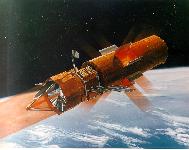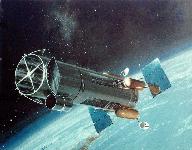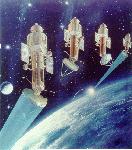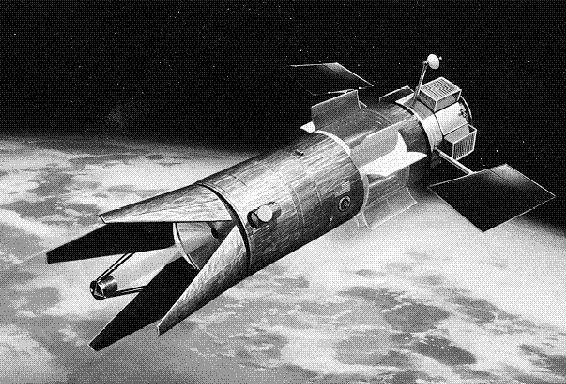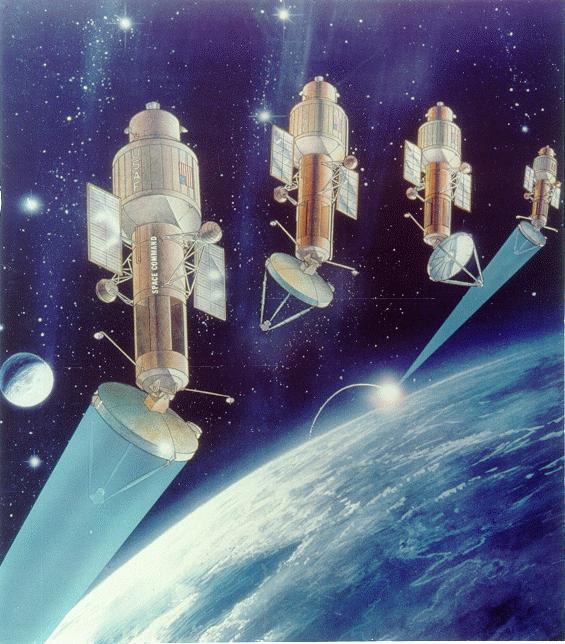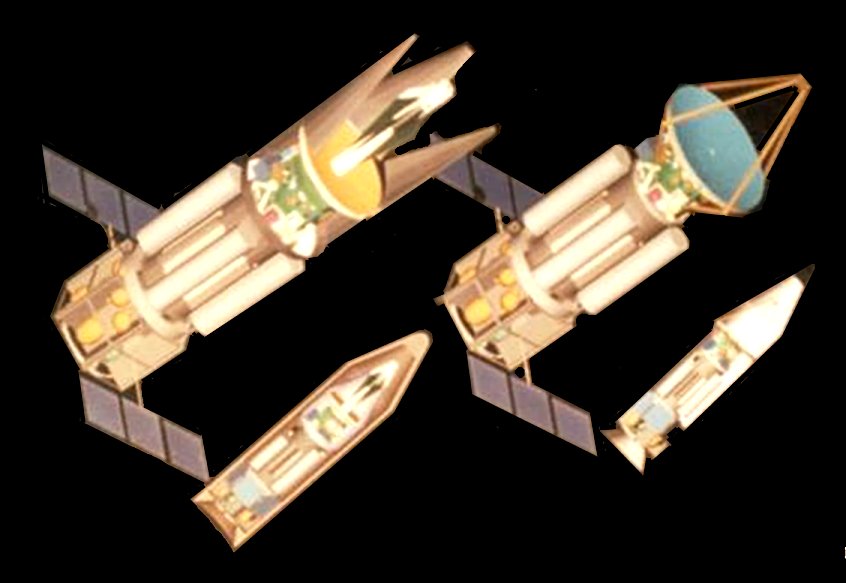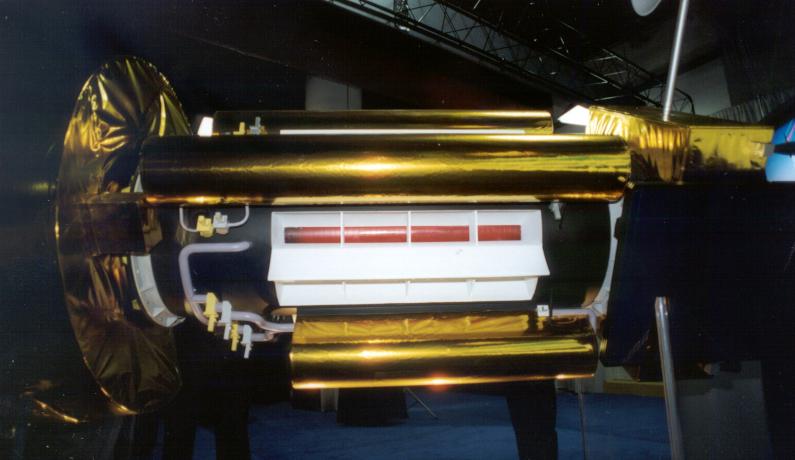|
Space Based Laser [SBL] |
|||||||||||||||||
| The potential to intercept and destroy a missile over
enemy territory soon after launch, rather than over friendly territory,
makes the development of a boost phase intercept
(BPI) capability very desirable. In concert with ground based theater
missile defense (TMD) systems already under development, the U.S.
continues to investigate BPI concepts for BMD systems.
The SBL program could develop the technology to provide the U.S. with an advanced BMD system for both theater and national missile defense. BMDO believes that an SBL system has the potential to make other contributions to U.S. security and world security as a whole, such as inducing potential aggressors to abandon ballistic missile programs by rendering them useless. Failing that, BMDO believes that the creation of such a universal defense system would provide the impetus for other nations to expand their security agreements with the United States, bringing them under a U. S. sponsored missile defense umbrella. An SBL platform would achieve missile interception by focusing and maintaining a high powered laser on a target until it achieves catastrophic destruction. Energy for the sustained laser burst is generated by the chemical reaction of the hydrogen fluoride (HF) molecule. The HF molecules are created in an excited state from which the subsequent optical energy is drawn by an optical resonator surrounding the gain generator. Lasers have been studied for their usefulness in air defense since 1973, when the Mid Infrared Advanced Chemical Laser (MIRACL) was first tested against tactical missiles and drone aircraft. Work on such systems continued through the 1980s, with the Airborne Laser Laboratory, which completed the first test laser intercepts above the earth. Initial work on laser based defense systems was overseen by the Defense Advanced Research Projects Agency (DARPA), but transferred to the newly created Strategic Defense Initiative Organization (SDIO) in 1984. Work continues today under the auspices of the BMDO, the successor to the SDIO. The SBL program builds on a broad variety of technologies developed by the SDIO in the 1980s. The work on the Large Optics Demonstration Experiment (LODE), completed in 1987, provided the means to control the beams of large, high powered lasers. The Large Advanced Mirror Program (LAMP) designed and built a 4 meter diameter space designed mirror with the required optical figure and surface quality. In 1991, the Alpha laser (2.8 mm) developed by the SDIO achieved megawatt power at the requisite operating level in a low pressure environment similar to space. Numerous Acquisition, Tracking, and Pointing/ Fire Control (ATP/ FC) experiments both completed and currently underway will provide the SBL platform with stable aimpoints. Successes in the field of ATP include advances in inertial reference, vibration isolation, and rapid retargeting/ precision pointing (R2P2). In 1995 the Space Pointing Integrated Controls Experiment offered near weapons level results during testing. Most recently, the Alpha LAMP Integration (ALI) program has performed integrated high energy ground testing of the laser and beam expander to demonstrate the critical system elements. The next step is an integrated space vehicle ground test with a space demonstration to conclusively prove the feasibility of deploying an operational SBL system. Future plans include orbiting the SBL Readiness Demonstrator (SBLRD) in order to test all of the systems together in their intended working environment. Designs for the SBLRD satellite call for four major subsystems: the ATP system; providing acquisition, tracking, targeting, stabilization, and assessment capabilities; the laser device, providing the optical power, and beam quality, as well as maintains nozzle efficiency; the optics and beam control systems, enhancing and focus the beam, augmenting the capabilities of the laser device; and the space systems, providing a stable platform, storage of the reactants, and furnish electrical power (but do not power the laser). The SBLRD is intended to demonstrate the capability to perform boost phase Theater Missile Defense from space. The objectives of the space demonstration include gaining performance information critical to the development of an operational SBL system, as well as gain a general understanding of operating such a system. BMDO and the Air Force agreed to transfer the execution of the SBLRD project and the related SBL technology developments to the Air Force. BMDO retained overarching SBL architecture responsibilities.
Current SBL planning is based on a 20 satellite constellation, operating at a 40? inclination, intended to provide the optimum TMD threat negation capability. At this degree of deployment, kill times per missile will range from 1 to 10 seconds, depending on the range from the missile. Retargeting times are calculated at as low as 0.5 seconds for new targets requiring small angle changes. It is estimated that a constellation consisting of only 12 satellites can negate 94% of all missile threats in most theater threat scenarios. Thus a system consisting of 20 satellites is expected by BMDO to provide nearly full threat negation. SBLRD Characteristics
Resources:
Reprinted from FAS.ORG http://www.fas.org/spp/starwars/program/sbl.htm Last Updated December 02, 2005 10:40:54 A.M. |
|||||||||||||||||
|
..
..
..
..
..
On December 12, 2002, Northrop Grumman completed its acquisition of TRW Inc. Information about former TRW defense businesses (Space & Electronics, now Space Technology, and Systems, now Mission Systems) can be accessed from the Northrop Grumman website at Please note that the Aerospace business has been integrated into Goodrich Corp., which can be found at www.goodrich.com
..
..
..
The following set of photos were
taken at the 4th
Annual Directed Energy (DE) Symposium, 29 October - 1 November
2001, held in Huntsville, Alabama by a clandestine camera. This is the
unveiling of the Space Based Laser (SBL)
..
..
..
..
|
|||||||||||||||||
| Megawatt Laser Test Brings Space
Based Lasers One Step Closer
Redondo Beach - April 26, 2000 In a demonstration of the rising maturity of high-energy lasers, TRW has conducted a test of the Alpha high-energy laser that produced a 25 percent increase in the laser's output power and improved its quality. The successful, six-second test of the megawatt-class Alpha was performed March 28 at TRW's Capistrano Test Site in Southern California as part of the Alpha Laser Optimization (ALO) program. ALO is funded jointly by the Air Force and Ballistic Missile Defense Organization (BMDO). The test marked not only the 22nd successful firing of the TRW-built Alpha, but also a significant step forward in the nation's disciplined maturation of the technology required to design and deploy the Space-Based Laser Integrated Flight Experiment (SBL IFX), an experimental, space-based missile defense system being developed by the Air Force. |
|||||||||||||||||
| FAIR USE NOTICE: This page contains copyrighted material the use of which has not been specifically authorized by the copyright owner. Pegasus Research Consortium distributes this material without profit to those who have expressed a prior interest in receiving the included information for research and educational purposes. We believe this constitutes a fair use of any such copyrighted material as provided for in 17 U.S.C ? 107. If you wish to use copyrighted material from this site for purposes of your own that go beyond fair use, you must obtain permission from the copyright owner. | |||||||||||||||||
|
|




